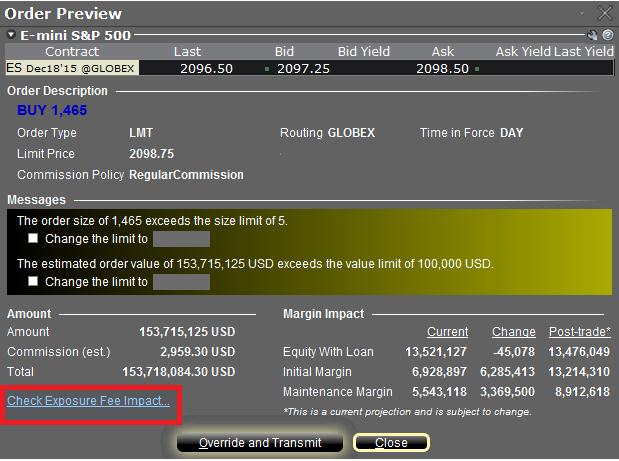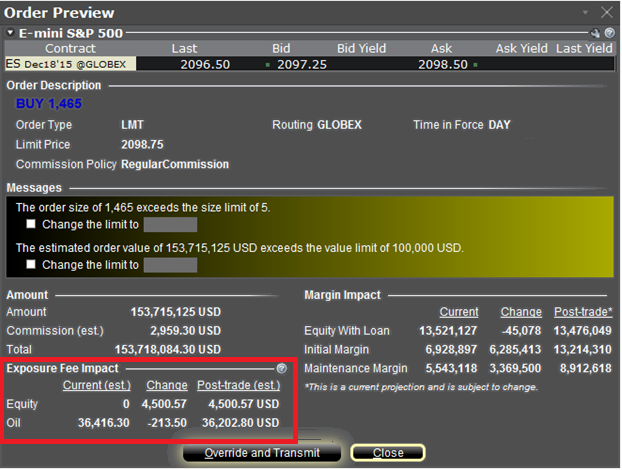Resumen de las metodologías de margen
Introducción
Dónde obtener más información
Herramientas proporcionadas para monitorizar y gestionar el margen
Cómo determinar el poder adquisitivo
Cómo determinar si está tomando fondos prestados de IBKR
¿Por qué IBKR calcula e informa un requisito de margen cuando no estoy tomando fondos prestados?
Vista previa de orden - Consulte impacto de tarifa de exposición
IB proporciona una función que permite a los titulares de cuenta comprobar qué impacto, si lo hubiere, tendría una orden sobre la Tarifa de Exposición proyectada. La función debería utilizarse antes de enviar la orden, para proporcionar una notificación por adelantado respecto a la tarifa y permitir que se realicen cambios en la orden antes de su envío para minimizar o eliminar la tarifa.
Esta función se activa si hace clic derecho en la línea de orden; se abrirá la ventana Vista Previa de Orden. Esta ventana contiene un enlace llamado "Comprobar el impacto de tarifa de exposición" (vea la casilla destacada en rojo en el ejemplo 1 siguiente).
Ejemplo I

Si hace clic en el enlace, se expandirá la ventana y se mostrará la tarifa de exposición, si la hubiere, asociada con las posiciones actuales, el cambio de la tarifa si se ejecutara la orden y la tarifa total resultante al ejecutarse la orden (vea la casilla destacada en rojo en el Ejemplo II siguiente). Estos saldos se desglosan más aún por clasificación de producto a la cual se aplica la tarifa (por eje. liquidez, crudo). Los titulares de cuenta pueden simplemente cerrar la ventana sin transmitir la orden si consideran que el impacto en la tarifa es excesivo.
Ejemplo II

Por favor, consulte el artículo KB2275 para información respecto al uso del Risk Navigator de IB para gestionar y proyectar la tarifa de exposición y el artículo KB2344 para monitorizar tarifas a través de la Ventana de Cuenta.
Utilizar el Risk Navigator para proyectar tarifas de exposición
El Risk Navigator de IB proporciona una función para personalizar escenarios que permite determinar el efecto, si lo hubiera, que tendrían los cambios de la cartera sobre la tarifa de exposición. Abajo se indican los pasos para crear una cartera “¿y si?” a través de cambios asumidos para una cartera existente o a través de una cartera propuesta completamente nueva junto al tiempo que se determina la tarifa resultante. Tenga en cuenta que esta función está disponible solo para la versión 951 y superiores de TWS.
.jpg)
.png)
.jpg)
.jpg)
.jpg)
.jpg)
.jpg)
.jpg)
Por favor, consulte el artículo KB2344 para más información sobre monitorización de la tarifa de exposición a través de la ventana de cuenta y el artículo KB2276 para verificar la tarifa de exposición a través de la pantalla Vista previa de Órdenes.
Order Preview - Check Exposure Fee Impact
IB provides a feature which allows account holders to check what impact, if any, an order will have upon the projected Exposure Fee. The feature is intended to be used prior to submitting the order to provide advance notice as to the fee and allow for changes to be made to the order prior to submission in order to minimize or eliminate the fee.
The feature is enabled by right-clicking on the order line at which point the Order Preview window will open. This window will contain a link titled "Check Exposure Fee Impact" (see red highlighted box in Exhibit I below).
Exhibit I

Clicking the link will expand the window and display the Exposure fee, if any, associated with the current positions, the change in the fee were the order to be executed, and the total resultant fee upon order execution (see red highlighted box in Exhibit II below). These balances are further broken down by the product classification to which the fee applies (e.g. Equity, Oil). Account holders may simply close the window without transmitting the order if the fee impact is determined to be excessive.
Exhibit II

Please see KB2275 for information regarding the use of IB's Risk Navigator for managing and projecting the Exposure Fee and KB2344 for monitoring fees through the Account Window
Important Notes
1. The Estimated Next Exposure Fee is a projection based upon readily available information. As the fee calculation is based upon information (e.g., prices and implied volatility factors) available only after the close, the actual fee may differ from that of the projection.
2. The Check Exposure Fee Impact is only available for accounts that have been charged an exposure fee in the last 30 days
Using Risk Navigator to Project Exposure Fees
IB's Risk Navigator provides a custom scenario feature which allows one to determine what effect, if any, changes to their portfolio will have to the Exposure fee. Outlined below are the steps for creating a “what-if” portfolio through assumed changes to an existing portfolio or through an entirely new proposed portfolio along with determining the resultant fee. Note that this feature is available through TWS build 971.0i and above.
.png)
.png)
.png)
.png)
.png)
.png)
.png)
Please see KB2344 for information on monitoring the Exposure fee through the Account Window and KB2276 for verifying exposure fee through the Order Preview screen.
Important Note
1. The on-demand Exposure Fee check represents a projection based upon readily available information. As the fee calculation is based upon information (e.g., prices and implied volatility factors) available only after the close, the actual fee may differ from that of the projection.
Overview of Margin Methodologies
Introduction
Where to Learn More
Tools provided to monitor and manage margin
How to determine if you are borrowing funds from IBKR
Why does IBKR calculate and report a margin requirement when I am not borrowing funds?
Margin Requirement on Leveraged ETF Products
Leveraged Exchange Traded Funds (ETFs) are a subset of general ETFs and are intended to generate performance in multiples of that of the underlying index or benchmark (e.g. 200%, 300% or greater). In addition, some of these ETFs seek to generate performance which is not only a multiple of, but also the inverse of the underlying index or benchmark (e.g., a short ETF). To accomplish this, these leveraged funds typically include among their holdings derivative instruments such as options, futures or swaps which are intended to provide the desired leverage and/or inverse performance.
Exchange margin rules seek to recognize the additional leverage and risk associated with these instruments by establishing a margin rate which is commensurate with that level of leverage (but not to exceed 100% of the ETF value). Thus, for example, whereas the base strategy-based maintenance margin requirement for a non-leveraged long ETF is set at 25% and a short non-leveraged ETF at 30%, examples of the maintenance margin change for leveraged ETFs are as follows:
1. Long an ETF having a 200% leverage factor: 50% (= 2 x 25%)
2. Short an ETF having a 300% leverage factor: 90% (= 3 x 30%)
A similar scaling in margin is also in effect for options. For example, the Reg. T maintenance margin requirement for a non-leveraged, short broad based ETF index option is 100% of the option premium plus 15% of the ETF market value, less any out-of-the-money amount (to a minimum of 10% of ETF market value in the case of calls and 10% of the option strike price in the case of puts). In the case where the option underlying is a leveraged ETF, however, the 15% rate is increased by the leverage factor of the ETF.
In the case of portfolio margin accounts, the effect is similar, with the scan ranges by which the leveraged ETF positions are stress tested increasing by the ETF leverage factor. See NASD Rule 2520 and NYSE Rule 431 for further details.
What happens if the net liquidating equity in my Portfolio Margining account falls below USD 100,000?
Portfolio Margining accounts reporting net liquidating equity below USD 100,000 are limited to entering trades which serve solely to reduce the margin requirement until such time as either: 1) the equity increases to above 100,000 or 2) the account holder requests a downgrade to Reg T style margining through Client Portal (select the Settings, Account Settings, Configure and Account Type menu options).
If a Portfolio Margining eligible account reporting net liquidating equity below USD 100,000 enters an order which, if executed, would serve to increase the margin requirement, the following TWS message will be displayed: "Your order is not accepted, margin requirement increase not allowed. Equity with loan value is less than 100,000.00 USD."
IMPORTANT NOTICE
Please note that requests to downgrade to Reg. T will become effective the following business day if submitted prior to 4:00 ET. Also note that as the Reg. T margining methodology generally affords less leverage than does Portfolio Margining, requesting a downgrade may lead to the automatic liquidation of positions in your account in order to comply with Reg. T. You will receive a warning message if that is the case at the time you request the downgrade.
-->
What positions are eligible for Portfolio Margining?
Portfolio Margining is eligible for US securities positions including stocks, ETFs, stock and index options and single stock futures. It does not apply to US futures or futures options positions or non-US stocks, which may already be margined using an exchange approved risk based margining methodology.
